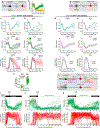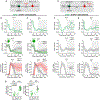Irreversible APC(Cdh1) Inactivation Underlies the Point of No Return for Cell-Cycle Entry
- PMID: 27368103
- PMCID: PMC6649667
- DOI: 10.1016/j.cell.2016.05.077
Irreversible APC(Cdh1) Inactivation Underlies the Point of No Return for Cell-Cycle Entry
Abstract
Proliferating cells must cross a point of no return before they replicate their DNA and divide. This commitment decision plays a fundamental role in cancer and degenerative diseases and has been proposed to be mediated by phosphorylation of retinoblastoma (Rb) protein. Here, we show that inactivation of the anaphase-promoting complex/cyclosome (APC(Cdh1)) has the necessary characteristics to be the point of no return for cell-cycle entry. Our study shows that APC(Cdh1) inactivation is a rapid, bistable switch initiated shortly before the start of DNA replication by cyclin E/Cdk2 and made irreversible by Emi1. Exposure to stress between Rb phosphorylation and APC(Cdh1) inactivation, but not after APC(Cdh1) inactivation, reverted cells to a mitogen-sensitive quiescent state, from which they can later re-enter the cell cycle. Thus, APC(Cdh1) inactivation is the commitment point when cells lose the ability to return to quiescence and decide to progress through the cell cycle.
Copyright © 2016. Published by Elsevier Inc.
Figures







References
-
- Aleem E, Kiyokawa H, and Kaldis P (2005). Cdc2-cyclin E complexes regulate the G1/S phase transition. Nat. Cell Biol. 7, 831–836. - PubMed
-
- Borel F, Lacroix FB, and Margolis RL (2002). Prolonged arrest of mammalian cellsattheG1/S boundary results in permanent S phase stasis. J. Cell Sci. 115, 2829–2838. - PubMed
-
- Davis PK, Ho A, and Dowdy SF (2001). Biological methods for cell-cycle synchronization of mammalian cells. BioTechniques 30, 1322–1326, 1328, 1330–1331. - PubMed
Publication types
MeSH terms
Substances
Grants and funding
LinkOut - more resources
Full Text Sources
Other Literature Sources
Miscellaneous

